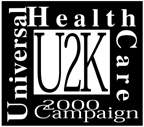Intro | Private Ins. | Medicare | Medicaid | Managed Care | Crisis | Reform

|
Employment-based Private Insurance |
History
In the United States, private insurance began in the early 1930s. The formation of Blue Cross was spurred during the Depression because, at that time of economic hardship, few people had money to pay their hospital bills after discharge. Hospital insurance, guaranteeing a flow of funds to hospitals, insured the hospitals' survival. Originally Blue Cross hospital insurance rates were "community rated" - all members of a community shared equally in the costs of care.
During World War II wages were controlled, but employers could raise fringe benefits to attract workers. Because of this "historical accident, "employer-based private health insurance came to dominate American health care in the 1950s. Private insurance companies moved in to take business away from Blue Cross by charging lower rates for companies with younger and healthier workers. This system, known as "experience rating," gradually undermined community rating.
As the technology of health care has advanced and care has become more expensive, a steady decline in the percentage of workers insured through their jobs has been the prime cause in the growth of uninsurance.
Current Status of Employment-based Private Insurance
Percentage of population under 65 receiving employment-based insurance:
| 1988 | 69.0% |
| 1990 | 67.0% |
| 1992 | 64.7% |
| 1994 | 63.6% |
| 1996 | 64.0% |
Private sector employers were the only source of for insurance for only 46% of the population in 1996.
Of the 161 million Americans who received employer-based insurance:
- 19 million also had government insurance.
- 9 million worked for an employer who did not contribute to the premium.
- 22 million worked for local, state or national government.
Percentage of uninsured workers by firm size, 1995:
| Fewer than 10 employees | 33% |
| 10-24 employees | 28% |
| Self-employed | 25% |
| 25-99 employees | 20% |
| 100-499 employees | 15% |
| 500-999 employees | 13% |
| More than 1000 employees | 12% |
Percentage of workers uninsured workers, by industry, 1995:
| Agriculture | 36% |
| Personal services | 32% |
| Construction | 31% |
| Business and repair services | 27% |
| Retail | 26% |
| Entertainment | 20% |
| Wholesale | 15% |
| Transportation | 13% |
| Manufacturing | 13% |
| Professional services | 12% |
| Mining | 10% |
| Finance | 8% |
| Government | 7% |
Sources of total health expenditures, 1994:
| Private employers | 21% | ||
| Government | 47% | (Medicare, Medicaid, payments for government employees, other public programs) | |
| Consumers | 26% | (out-of-pocket expenses, private insurance premiums) | |
| Nonpatient revenue | 6% |
Average cost of premiums for medium and large employers, 1997:
| Single | Family | |
| Conventional | $2311 | $6033 |
| HMO | $1920 | $5157 |
| PPO | $2028 | $5325 |
| POS | $2021 | $5572 |
Proportion of premium paid by employee, by firm size 1996:
| Small (<200 employees) | Medium and Large | |
| Single coverage | 33% | 22% |
| Family coverage | 44% | 30% |
Current Policy Issues
Employers in high wage industries don't want to give up employment-based insurance because they feel it gives them the ability to control their health care costs. They have been the main force promoting managed care and moving their employees into managed care plans.Employers with low wage workers often can't afford health insurance for their employees. The slight upward income expansion of Medicaid eligibility (see below) is providing some help to workers in low wage industries, but private insurers don't want Medicaid eligibility to get too high out of fear it will cut into their business.
Leading health system analysts are deeply divided on whether it makes sense for the United States to remain the only nation in which employment is the basis for health coverage.